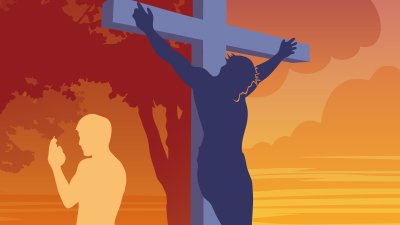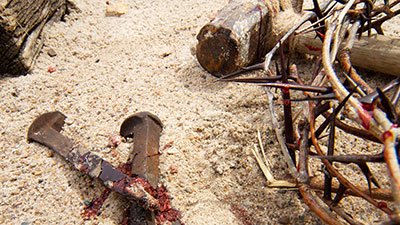What Does Jesus’ Death Accomplish?
If Jesus suffered the punishment for death on our behalf, why do we still die?
Consider further the following:
- Our sins are removed from us as far as the east is from the west (Psalm 103:12).
- We are set free from the law of sin and death (Romans 8:1–4), yet we continue to sin (Paul chronicled his struggle in Romans 7).
- Jesus “has borne our griefs and carried our sorrows” (Isaiah 53:4), yet many continue to suffer from horrible illnesses even after they receive the gift of eternal life.
- The kingdom of God is one of righteousness, peace and joy in the Holy Spirit (Romans 14:17), yet we continue to cry and experience great sorrow.
At the end of his creative acts, God declared his completed creation “very good” (Genesis 1:31). He gave the animals and humans plants to eat (Genesis 1:29–30). The Creator promised Adam that if he disobeyed the command to not eat from the Tree of the Knowledge of Good and Evil, he would surely die (Genesis 2:15–17). This, indeed, happened after Adam disobeyed; Adam and Eve would now return to the dust from which they were formed (Genesis 3:19). In an act of mercy, God sent them from the Garden of Eden so that they would not live forever in their sinful state (Genesis 3:22–23) in the now-corrupted creation (Genesis 3, Romans 8:18–22).
A Temporary Solution
The first animal death occurred when God made coats of skin to cover Adam and Eve (Genesis 3:21). Throughout the rest of the Old Testament, this pattern of atonement for sins is followed: physical death of a perfect animal (i.e., without blemish or spot) on behalf of the sinner (although the blood of these bulls and goats could not take away sins (Hebrews 10:4)). This pattern culminated in the real thing (which God had promised in the beginning—Genesis 3:15)—the physical death of the perfect Lamb of God on the Cross on behalf of his people. Jesus died—he was separated from his Father, and died a physical death, just as the first Adam did. But Jesus rose from the dead (1 Corinthians 15:20–22)—something Adam could not do.
When we receive the free gift of eternal life, we are passed from death to life (John 5:24). But because the whole creation is still suffering from bondage to decay and will continue to groan until the day of redemption (Acts 3:21), we still physically die to shed our mortal sin-filled bodies. As Paul said, flesh and blood cannot inherit the kingdom of God (1 Corinthians 15:50–53), although we are already heirs of God (Romans 8:17); we must shed our perishing bodies in order to inherit eternal life. Until Christ comes again and brings about the new heavens and earth, physical death is, for those who believe, their usher into eternal life with the Creator in their free-from-the-Curse bodies (1 Corinthians 15:35–58). Although we still die, Jesus removed the “sting” of death for his children (1 Corinthians 15:54–57) with the promise of life eternal. Those who reject the free offer of eternal life will die the second death (Revelation 2:11; 20:6, 14; 21:8). Physical death is the merciful way that God has given us to pass into his presence, instead of living forever in our sinful state with sin-filled bodies that are suffering from 6,000 years of the Curse. Christ’s substitutionary death took away the Curse of sin for believers, allowing for their continued sanctification throughout their lives here on earth, but we must still suffer the consequences (e.g., death, disease, pain) of our sin.
Restored?
If, as some suggest, the earth and its fossil record, which is a record of physical death, disease (cancerous tumors have been found in some animal fossils, including dinosaurs) and carnivory, is millions of years old, then physical death is not the punishment for sin that Genesis 3 shows it to be. Death would have been a part of the world since before humans appeared on the scene, and thus, before humans sinned. God would have had no reason to sentence Adam and Eve to death (Genesis 2:17; 3:19–24), as they would have eventually died anyway. Further, Jesus would have no reason to suffer a horrible physical death, as death would have been part of God’s “very good” creation. In the “millions of years” scenario, death is no longer the “last enemy” (1 Corinthians 15:26) to be conquered, but a very natural and good part of God’s creation.
Further, those who have received the free gift of eternal life through the death and Resurrection of Jesus Christ have the promise that the creation will be “restored” to its original “very good” state (Acts 3:21; Romans 8:20–22; Revelation 21:4, Revelation 22:3). If the original creation would have been filled with diseases, pain, suffering, and death, where is the hope in this promise? For what reason did Jesus die and rise again, if only to offer us a promise of restoration back to the way it was (and the way it is now)—a world filled with violence, death, and suffering? Instead, we who have inherited eternal life look forward to the Resurrection, when our sin-filled, disease-ridden bodies will be exchanged for glorious bodies full of life, therefore defeating death (1 Corinthians 15). In the new heavens and earth, we will once again have access to the Tree of Life (Revelation 2:7; Revelation 22:1–5). In this new paradise, we will no longer sin (our sanctification is complete), we will no longer cry, experience pain, or suffer debilitating diseases; we will not experience the second death.
Additionally, the future will include a change in the animal kingdom, to return them to their original vegetation-eating state (Isaiah 11:6–9). If animals had been carnivores since the beginning (indicated by a millions-of-years-old fossil record full of evidence of carnivory), the future restoration is nothing of the sort—it is merely status quo.
In this restoration we finally realize the complete fulfillment of all of God’s promises to his children and see, in fullness, with all the believers of all time, the great work that Jesus Christ accomplished.
Recommended Resources

Answers in Genesis is an apologetics ministry, dedicated to helping Christians defend their faith and proclaim the good news of Jesus Christ.
- Customer Service 800.778.3390
- © 2024 Answers in Genesis







